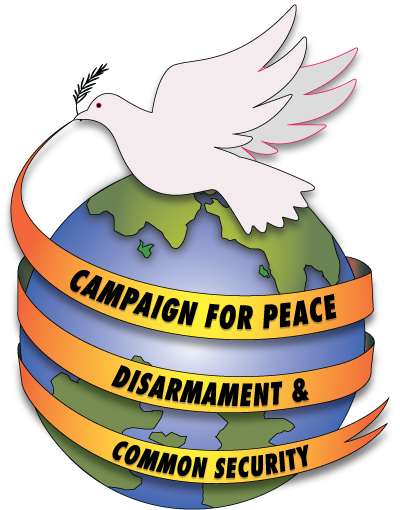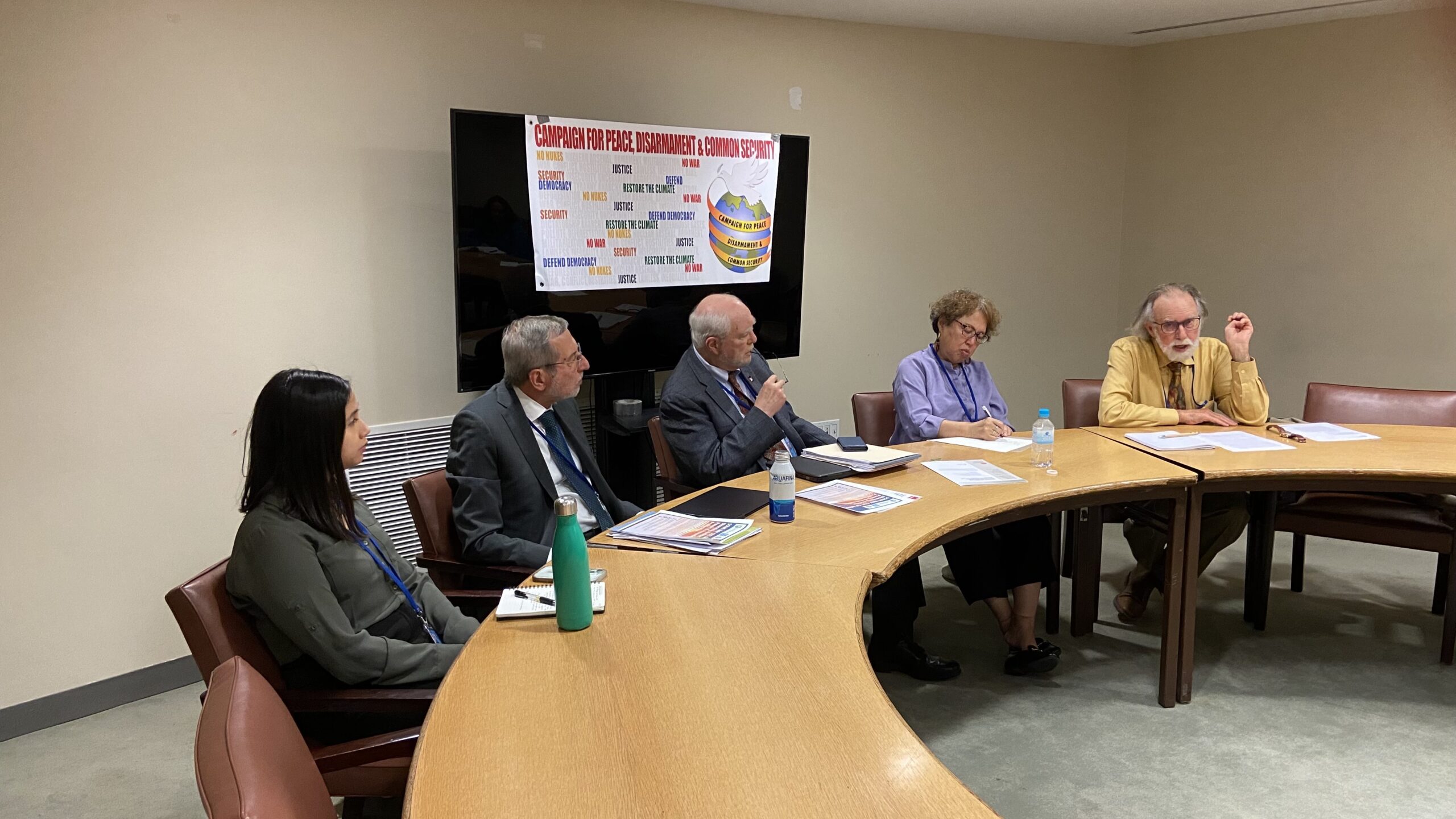It was our pleasure to welcome John Burroughs to speak in our CPDCS/IPB/PANYS side event during the Nuclear Nonproliferation Treaty PrepCom on April 29. The session was titled “SOME WAY OUT OF HERE: Disarming Nuclear Powers & Preventing Proliferation.
We wanted to take stock on the achievements of the Treaty on Prohibition of Nuclear Weapons, challenges to the Treaty and its universalization, and what our movements can best do to promote the Treaty. Take a look and take action.
The Treaty on the Prohibition of Nuclear Weapons – TPNW – is a marvelous statement of the principles and goals that should guide the abolition of nuclear arms and their non-use and non-threat before and after the weapons are eliminated. Those principles and goals have been set out over the decades in General Assembly resolutions and elsewhere, but the TPNW has made them highly visible. The treaty itself is a 10-page document which should be used for education – read this and learn about why nuclear arms should be abolished. The how part I’ll address later.
One important example of how the TPNW has highlighted an important point in international relations concerns nuclear threats. The TPNW prohibits threat as well as use of nuclear weapons. The first meeting of states parties, held in June 2022, soon after Russia had backed its invasion of Ukraine with nuclear threats, adopted a declaration which among other things stated: “We stress that any use or threat of use of nuclear weapons is a violation of international law, including the Charter of the United Nations. We condemn unequivocally any and all nuclear threats, whether they be explicit or implicit and irrespective of the circumstances.” Just a few months later, the G-20, an intergovernmental forum including the world’s major powers meeting in Bali, Indonesia, adopted a declaration stating that “the threat or use of nuclear weapons is inadmissible.”
The second and third meetings of TPNW states parties have continued to condemn nuclear threats, with the declaration of the just held third meeting stating that nuclear threats violate the UN Charter and international humanitarian law, and are inadmissible.
With its scores of non-nuclear weapon states parties, the TPNW has also strongly reinforced the obligation of non-acquisition of nuclear weapons found in the NPT and in regional NWFZ treaties. It’s not insignificant, for example, that the fourth largest country in the world, Indonesia, has joined the treaty. Another populous member is Nigeria. The TPNW has added an important element not found in the NPT and regional NWFZs, non-cooperation with reliance on nuclear weapons. This could be important, for example, in the case of the Philippines, in any confrontation or conflict between its ally, the United States, and China.
Nuclear-armed states and their allies, as well as other states that have not joined the TPNW, should treat the TPNW with respect. They should recognize the contribution that it has made to changing the paradigm on nuclear weapons, and they should cooperate with the TPNW where possible.
What about nuclear-armed states joining the treaty? First of all, let me say that there is currently no indication that nuclear-armed states have an interest in nuclear abolition or specifically in joining the TPNW.
But let’s say there was such interest in nuclear abolition. The TPNW would not have to be the path that nuclear-armed states and their allies took. But if they did want to join the TPNW, there are ways that could happen. They could engage in verified reductions leading to zero, and then join the TPNW, perhaps with additional institutional infrastructure.
My organization, Lawyers Committee on Nuclear Policy, together with the International Network of Engineers and Scientists Against Proliferation and the International Physicians for the Prevention of Nuclear War, in the 1990s developed a Model Nuclear Weapons Convention. It’s a comprehensive treaty, comparable in some respects to the Chemical Weapons Convention. It addresses all aspects of elimination of nuclear arms – verification, enforcement, how nuclear power is handled, etc. So somebody who is interested in how the TPNW can contribute to nuclear disarmament can take a look at the model convention and see what’s missing in the TPNW.
It’s a complicated subject, and I’m not going to address it in depth, but let me mention a few points. The TPNW does not address nuclear weapons delivery systems. Provisions for verification are vague and rely upon an unspecified international authority. There are no provisions for enforcement or inducement of compliance. There is a withdrawal provision that is somewhat stronger than the one in the NPT, but it still allows for withdrawal. Do you want a withdrawal option in a nuclear-weapon-free world? I don’t think so.
How could such issues be addressed if nuclear-armed states want to join the treaty? There is the option set out in TPNW of protocols to the treaty. They could develop the verification provisions of the treaty, or address delivery systems, or establish enforcement and compliance mechanisms. As I mentioned, nuclear-armed states might develop institutions and procedures in the course of verified reductions leading to zero which they could in effect bring with them on joining the TPNW.
Why am I going through this exercise? It needs to be understood that there are complex issues to be resolved if the TPNW is to be used as a vehicle for disarmament. I say again that the TPNW is a marvelous statement of principles and goals that should guide nuclear abolition. Also, TPNW states parties are setting out to make some concrete contributions which I’ll talk about briefly.
I attended the 3d meeting of states parties to the TPNW held March 3-7 here at UN Headquarters. As with previous meetings, there was substantial NGO involvement– about 1000 NGO individuals attended, and energy and engagement from the NGOs and many states parties, especially the core states. It’s inspiring. I think there’s also a sense that the TPNW enterprise is not limited narrowly to the treaty and its procedures.
The Scientific Advisory Group tends to be taking that approach. At the meeting, the group provided a 17-page update to its 2023 report. I recommend the update. The 15-member group has established a pilot network of scientists with 23 members, and engages with other scientists as well in various settings. A decision of the TPNW meeting was that Mexico will lead a consultative process on renewal of the SAG’s mandate and terms of reference at the first review conference in late 2026.
A second thing that stood out to me at the meeting of states parties was a report about a consultative process concerning security concerns of non-nuclear weapon states arising from the reliance of some states nuclear weapons, so-called “nuclear deterrence”. The report was presented by the coordinator for the process, Alexander Kmentt of Austria.
In its News in Review publication, Reaching Critical Will provides a good overview of the report, stating in part: “Some of the key points in the report are that the humanitarian consequences and risks of nuclear weapons are graver and more complex than previously understood, with many direct impacts on TPNW states. Thus, seeking to eliminate these risks is a prime responsibility and legitimate concern for TPNW states. The report also finds that nuclear deterrence theory carries many uncertainties. It makes assumptions about stability, predictability, and rationality …..”
This process is going to continue, with engagement and outreach in various international settings. They are seeking to do further research on the complex, long-term effects of nuclear use.
The report is long and somewhat duplicative, and I won’t try to go over its main points beyond what I have already said. I do want to offer one criticism. Reliance on nuclear weapons comes in many forms. A very good example of this is Israel, which has nuclear weapons but is basically silent on the subject. It has no articulated doctrine of “deterrence” as Russia and the US have had basically since the beginning of the nuclear age. But a lot of the report’s critique seems to be directed at the US-Russian relationship, with their large arsenals and deterrence doctrines. That is not the only scenario for use of nuclear weapons.
The last thing I’ll mention about the recent TPNW meeting is that a working group led by Kazakhstan and Kiribati has been developing the concept of a trust fund for victim assistance and environmental remediation. Based on the treaty, the scope is limited to effects of use of nuclear weapons and of nuclear explosive testing – not uranium mining or production of nuclear weapons. Such a fund is not referred to in the text of the treaty, but establishing a fund has significant support among states parties, partly because it would be one means of meeting the obligation under the treaty to cooperate in victim assistance and environmental remediation. Trust funds operate in other treaty regimes, for example landmines and cluster munitions.
The states parties meeting just held decided that the working group will engage in further development of the trust fund concept, engaging in wide consultations, on such matters as the guidelines and technical provisions of a Trust Fund. The aim is to establish, if feasible, a Trust Fund at the first review conference, to be held in late 2026.
Issues remaining to be resolved include whether contributions can come from states not party to the treaty, including nuclear-armed states, and from other entities such as foundations. Another issue is who can receive grants from the fund. Would it be only states parties? Or could such entities as international organizations and civil society organizations receive grants?
There are other complex questions to be worked out. Who is a victim? That is in part a medical and scientific question. Also, what environmental remediation measures are worth doing, in terms of what they accomplish and what they cost? I will stop there.

